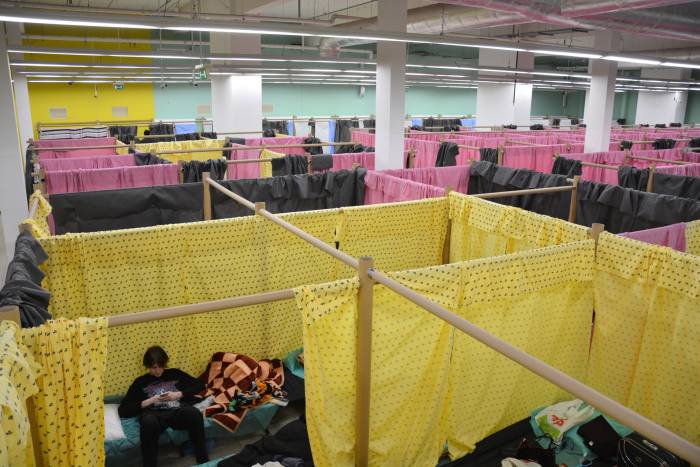
The London Design Biennale, which opens at Somerset House next week, has sometimes felt like a World’s Fair of blue-sky ideas, most of them thought provoking but few likely to translate to real-world applications.
This year, in its fourth iteration, a vein of practicality runs through the biennale, balancing the purely conceptual exhibits. Artistic direction is in the hands of the Dutch design centre Het Nieuwe Instituut, led by Aric Chen, who sees a chance to use the showcase to nurture and promote design-led answers to pressing problems.
“We have got very good about posing questions and raising awareness of issues,” says Chen. “But at a certain point we have to ask ourselves, ‘can we do more?’ ”
This urge to show solutions rather than just air dilemmas is most obvious in a clutch of installations responding to the war in Ukraine. Poland’s Adam Mickiewicz Institute is displaying (and collecting) salvaged window frames, continuing a project in which Polish citizens have donated hundreds of windows removed during building renovations to replace those destroyed by bombing in Ukrainian cities.
Japanese architect Shigeru Ban has assembled the Humanitarian pavilion, modelling his Paper Partition System, recently used to create temporary private enclosures from cardboard tubes and cloth curtains for refugees in Ukraine’s school halls.

Ukraine’s own room, its windows criss-crossed with the tape used by citizens to limit flying glass shards, features bold textile hangings and clay vessels in futuristic shapes, to show the resilience of the country’s design community. “We had meetings when they said, ‘Sorry we couldn’t do anything this week because we have been underground in a bunker for three days,’ ” says biennale director Victoria Broackes of the pavilion’s Kyiv-based organisers.
The biennale’s strapline is “The global game: remapping collaborations”, and design teams worldwide have been encouraged to share ideas and research from the early stages. Broackes says it was an appropriate response to a global drawing in of horns. “A few years ago one felt that national boundaries were more fluid,” she says. “There is a sense in which people are back behind closed walls and doors now.”
“In a cheeky way we saw ourselves as like the UN,” adds Chen. “All we can do is create frameworks for collaboration.”
To promote transnational partnership, the Instituut commissioned Amsterdam studio Play the City to design a facility Chen compares to an online dating app, where the design teams post their profiles and interests and search for like minds to work with.
The early successes are reflected in a few joint pavilions. Spain and Peru have combined to highlight shared cultural history by showcasing the cajón, a box-shaped drum that originated in Afro-Peruvian music but has been adopted by flamenco musicians. The Danish and Swiss consortiums are exhibiting the model of Blue Nomad, a solar-powered “floating habitat” made of waterproofed flax, which the designers intend to build full scale for a 2,000-mile voyage round Europe’s coasts.
Het Nieuwe Instituut has modelled the co-operative spirit in its own Netherlands pavilion, which is built of demountable boxes designed to double as seats and lecterns that can be borrowed by other pavilions to stage talks and happenings, spreading the installation throughout the building.
Many of the Biennale’s displays blur the lines between the physical world and virtual environments. In the South Korean pavilion, visitors will sit in a traditional timber shelter, don VR goggles and be transported to a 16th-century garden where scholars would once wander to clear their minds.
In the US installation titled “A species between worlds”, artist John Mack explores what he calls “the digital takeover of human consciousness” through his spectacular landscape photographs merged with flat renderings of the same spaces by the Pokémon Go game app.

Glowing fibre-optic textiles hanging in Somerset House’s grand Nelson Staircase will pick up and react to onlookers’ brainwaves via headsets in the Inner Peace installation by a multidisciplinary group including the Royal College of Art and architects Foster + Partners.
The strong digital presence reflects the zeitgeist, but also hard economic reality. It is often less expensive to exhibit a screen-based installation than to build a room full of fragile objects and ship them halfway around the world. “There’s not a lot of money around to do this kind of thing,” Broackes admits. “European countries that would have had a budget no longer have one. Sponsorship is harder to come by.”
But funding constraints have not robbed the biennale of three-dimensional show-stoppers. Dubai’s exhibitors have half-filled their room with sand dunes, then added a Mars space probe. In the central courtyard, Open Square Collective has built a maze echoing the layout of a typical Maltese village, made of wooden frames hung with purple drapes, alluding to the highly valued imperial purple dye extracted from sea snails by the Phoenicians.

For all the spectacle, Chen hopes that the month’s exhibits will be just the tip of an iceberg of work between the participants for years to come. Het Nieuwe Instituut will also distil lessons from the collaborative process it sponsored to see how it could be improved.
“It’s about step by step changing the role of cultural institutions to be more useful,” he says. “Can we take some of these ideas and propositions forward and begin to change reality?”
June 1-25; londondesignbiennale.com
Find out about our latest stories first — follow @FTProperty on Twitter or @ft_houseandhome on Instagram
Stay connected with us on social media platform for instant update click here to join our Twitter, & Facebook
We are now on Telegram. Click here to join our channel (@TechiUpdate) and stay updated with the latest Technology headlines.
For all the latest Art-Culture News Click Here
